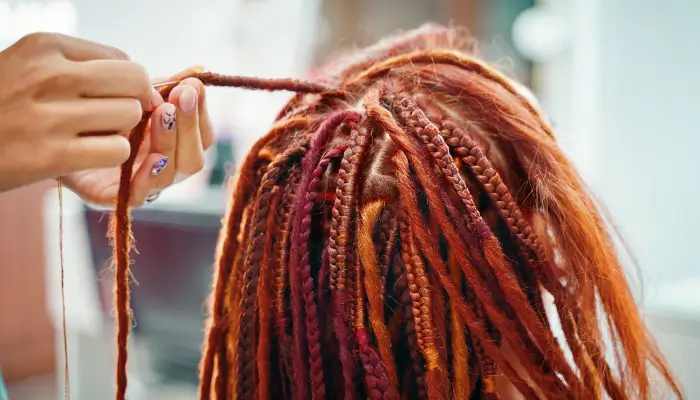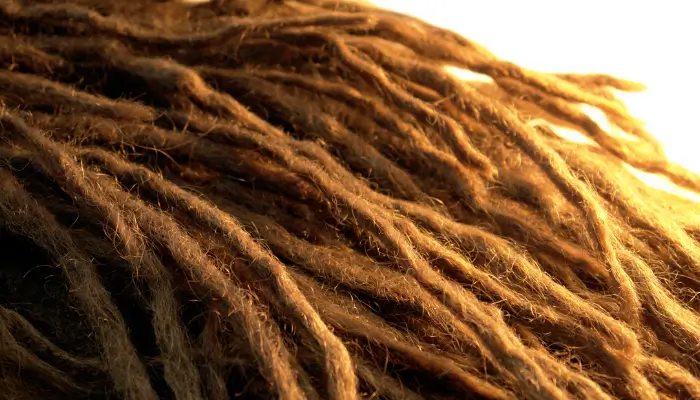Table of Contents
Dreadlocks and braids are two popular hairstyles that have been around for centuries. Each style has its unique appearance, cultural significance, and creation process, making it essential to understand the differences between the two before choosing one over the other.
Dreadlocks are matted and knotted hair that forms rope-like strands. They are typically created using a method that involves twisting or interlocking the hair into sections, which then naturally locks over time. In contrast, braids involve weaving strands of hair into intricate patterns, creating a unique and elegant look.
While both hairstyles have their unique benefits, they also come with several factors to consider when deciding which one to choose. Understanding the differences between dreadlocks and braids can help make an informed choice that is best suited to individual preferences and lifestyle.
Key Points – Dreadlocks vs Braids
- Dreadlocks are matted and knotted hair that form rope-like strands.
- Braids involve weaving strands of hair into intricate patterns, creating a unique and elegant look.
- Both hairstyles have their unique appearance, cultural significance, and creation process.
- Individual preferences and lifestyle play a significant role in deciding between dreadlocks and braids.
- Understanding the differences between both hairstyles is crucial before making a choice.
Benefits of Dreadlocks
Dreadlocks vs Braids benefits. Dreadlocks are a unique hairstyle that offers several benefits. One of the most significant advantages of having dreadlocks is that they require minimal maintenance. Unlike other styles, dreadlocks don’t need to be combed or brushed regularly, which can save time and effort on daily styling routines.
Another benefit of dreadlocks is their versatility in styling. With the ability to part and shape them in various ways, individuals can create unique looks that complement their personal style. Additionally, dreadlocks have a natural beauty that can enhance the features of the face and head, making them an attractive option for many individuals.
However, there are also potential drawbacks to consider when getting dreadlocks. One of the most common issues with dreadlocks is the build-up of lint and product, which can cause discomfort and irritation. Additionally, maintenance appointments with a professional loctician may be necessary, which could represent an additional expense.
Benefits of Braids

Benefits of Braids. Braids are one of the most versatile hairstyles that offer endless styling possibilities. They are not only stylish, but they also have numerous benefits for natural hair. Here are some of the advantages of choosing braids as a go-to hairstyle:
- Protective Nature: Braids are a perfect protective style that helps to shield your hair from daily stress and breakage. They work by preventing tangling and reducing manipulation, which can result in hair loss.
- Style Versatility: Braids come in various styles, shapes, and sizes that allow you to express your personality and creativity. You can choose from box braids, cornrows, twists, or even add extensions for more length and volume.
- Low-Maintenance: Braids are a low-maintenance hairstyle that requires minimal effort when it comes to daily styling. You can easily maintain them by washing and moisturizing your scalp to keep your hair healthy and hydrated.
- Promotes Hair Growth: Braids promote hair growth by protecting the hair from breakage and daily manipulation. When done correctly and kept for the recommended duration, braids can help your hair to grow longer and healthier.
However, there are also some things to consider when opting for braids:
- Braids can sometimes cause tension on the hairline, leading to thinning or hair loss. It is essential to avoid tight braids and take breaks in between to allow the hair to rest.
- Some people may experience scalp irritation due to the weight of the braids or the hair extensions added. Ensure that the hairstyle is not too heavy, and avoid using hair extensions that are too tight or cause discomfort.
- Braids can take up a lot of time and can be costly to maintain, especially if you opt for intricate styles or expensive hair extensions. Ensure that you budget accordingly and factor in regular salon appointments for washing, conditioning, and retouching.
Maintenance Tips for Dreadlocks

Tips on how to maintain dreadlocks. Dreadlocks are a unique and beautiful hairstyle that requires proper maintenance to keep them healthy and looking their best. Follow these tips to maintain your dreadlocks:
Proper Cleansing Techniques
Cleanse your dreadlocks every 7-10 days using a sulfate-free shampoo. Be sure to massage the shampoo throughout your scalp, saturating your locs to ensure thorough cleaning. Rinse your hair thoroughly to prevent any remaining residue.
Conditioning Your Locs
While dreadlocks do not require daily conditioning, it’s essential to condition your hair regularly. Choose a leave-in conditioner to moisturize your locs and prevent dryness.
Preventing Lint and Product Buildup
Lint and product buildup can be detrimental to your dreadlocks. Always wrap your hair with a silk scarf or cap when sleeping to protect your hair from lint. Also, use natural products in moderation to avoid buildup.
Keep Your Scalp Healthy
A healthy scalp is essential for healthy dreadlocks. Moisturize your scalp regularly to prevent dryness, and use tea tree oil or witch hazel to prevent itchiness.
Regular Appointments with a Professional Loctician
It’s essential to schedule regular appointments with a professional loctician to maintain the health of your locs. They can provide deep cleansing and maintenance services to keep your dreadlocks healthy and gorgeous.
Maintenance Tips for Braids
How to maintain braids. When it comes to maintaining braids, there are a few key things to keep in mind in order to ensure that they look great and stay healthy. Below are some tips that will help:
Washing and Moisturizing
Regular washing and moisturizing are crucial for keeping braids looking clean and healthy. When washing, be sure to use a gentle shampoo that won’t cause buildup or damage to the braids. Focus on cleansing the scalp and roots, but avoid scrubbing the braids themselves, as this can cause frizzing or unraveling. Follow up with a lightweight conditioner or leave-in moisturizer to keep the hair hydrated and healthy.
Protecting the Hairline and Edges
One of the biggest challenges of wearing braids is preventing damage to the hairline and edges. To avoid this, be sure to maintain a loose tension when braiding the hair, and be mindful of the amount of hair being pulled and twisted. Additionally, consider wearing a satin or silk scarf or bonnet at night to protect the hairline and edges while sleeping.
Preventing Frizz and Breakage
Braids are susceptible to frizz and breakage, especially if they are left in for an extended period. To minimize these concerns, avoid over-manipulating the braids or exposing them to excessive heat or sun. Be gentle when styling or brushing the braids, and consider using a lightweight oil or serum to minimize frizz and add shine.
Recommended Duration and Safe Removal
Finally, it’s important to note that braids should not be left in for too long, as this can cause damage to the hair follicles and lead to breakage and thinning. As a general rule, braids should be removed after no more than 8 weeks. To safely remove braids, use scissors to cut them at the base, being careful not to cut any of the natural hair. Once the braids are removed, be sure to cleanse and condition the hair thoroughly to remove any buildup or residue.
View Hair Braid Accessories on Amazon
Final Thoughts – Dreadlocks vs Braids
Choosing between dreadlocks and braids ultimately comes down to personal preference. While both styles offer unique benefits and cultural significance, it’s important to consider factors such as maintenance requirements, desired hairstyles, and overall lifestyle when making a decision.
Those seeking a low-maintenance, versatile style may prefer dreadlocks, while those looking for a protective, growth-promoting style may opt for braids. Additionally, some individuals may simply prefer the appearance of one style over the other.
It’s important to note that both dreadlocks and braids require regular maintenance and care to remain healthy and vibrant. Whether it’s regular visits to a loctician or at-home cleansing and moisturizing, taking care of the hair is crucial.
Ultimately, the decision to choose between dreadlocks vs braids should be based on an individual’s personal preferences and lifestyle. By considering the differences and benefits of each style, one can make an informed decision that’s right for them.




